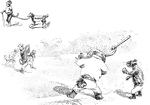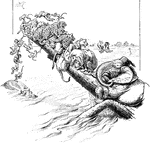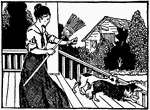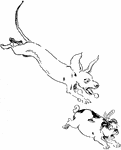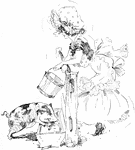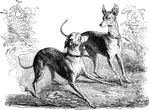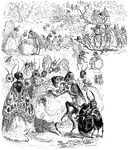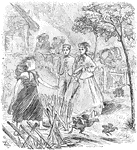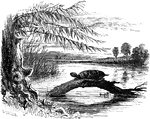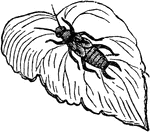
Earwig Pupa
An illustration of an earwig pupa. Earwigs is the common name given to the insect order Dermaptera characterized…

Earwig
Earwigs is the common name given to the insect order Dermaptera characterized by membranous wings folded…

Mole
Moles are the majority of the members of the mammal family Talpidae in the order Soricomorpha. Although…

Lemming
Lemmings are small rodents, usually found in or near the Arctic, in tundra biomes. Together with the…

Simple Crinoid
An illustration of a simple five armed crinoid with a detailed view of the tegmen of five orals. Crinoids,…
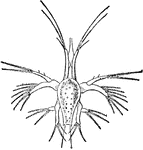
Nauplius of a Prawn
A nauplius (plural nauplii) is the first larva of animals classified as crustaceans (subphylum of Arthropoda).…

Gastrotricha
A small group of fairly uniform animals which live among Rotifers and Protozoa at the bottom of ponds…

Façade Tile from the Temple of Diana at Ephesus
On the apex and two lower angles of the pediment were introduced acroteria, sometimes ornaments of flowers…
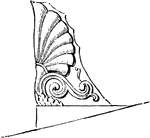
Acroteria, or Roof-Pedestal, from the Temple of Theseus at Athens
On the apex and two lower angles of the pediment were introduced acroteria, sometimes ornaments of flowers…
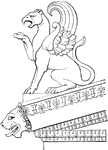
Acroteria from the Temple of Minerva at Ægina
On the apex and two lower angles of the pediment were introduced acroteria, sometimes ornaments of flowers…

Roman Leaf Festoon
The Roman Leaf Festoon was hung as a decoration on the friezes of temples, alternating with the real…
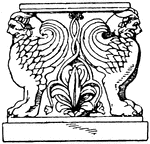
Antique Table Support Trapezophoron
The Antique table support is designed with the figures of winged animals.

Dasychone Infracta
An illlustration of a dasychone infracta, a type of annelid. The annelids, collectively called Annelida…
Balance, Dynamometer
"Balance-dynamometer (elevation). An apparatus for measuring the amount of force expended by men, animals,…

Balance, Dynamometer
"Balance-dynamometer (elevation). An apparatus for measuring the amount of force expended by men, animals,…
Disk-floret of the Senecio
An illustration of a disk-floret of the senecio flower. Senecio is a genus of the daisy family (Asteraceae)…

Disk-floret of the Senecio (Longitudinal Section)
An longitudinal section view of a disk-floret of the senecio flower. Senecio is a genus of the daisy…

Female ray-floret of the Senecio
An illustration of a ray-floret of the senecio flower. Senecio is a genus of the daisy family (Asteraceae)…
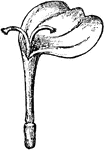
Gynaeceum of the Senecio
An illustration of the gynaeceum of the senecio flower. Senecio is a genus of the daisy family (Asteraceae)…
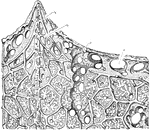
Upper Section of Sponge
An illustration of the upper portion of a sponge: p, Pore; s, Subdermal cavity; c1, chief fiver of the…
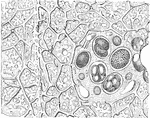
Lower Section of Sponge
An illustration of the lower portion of a sponge. O, OS, and M are illustrations of sponge eggs magnified…
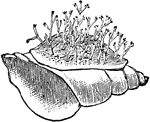
Hydrozoa Encrusting a Small Shell
Hydrozoa (hydrozoans) are a taxonomic class of very small, predatory animals which can be solitary or…

Medusa of a Hydroid
Colonial, plant-like animals closely related to jellyfish, with stinging cells, Any member of the invertebrate…
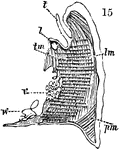
Perpendicular Section of a Sea Anemone
An perpendicular section of a sea anemone. Sea anemones are a group of water dwelling, predatory animals…
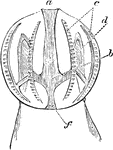
Ctenopore
The phylum Ctenophora , commonly known as comb jellies, is a phylum that includes the sea gooseberry…
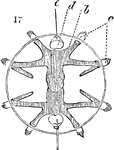
Transverse Section of Ctenopore
The phylum Ctenophora , commonly known as comb jellies, is a phylum that includes the sea gooseberry…

Farm Animals in Corral
An illustration of farm animals, including two horses, three pigs, and a cow.
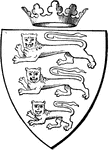
Three Lions Passant Gardant
Three Lions Passant Gardant. The escutcheon shows three lions passant (walking left with a leg raised)…
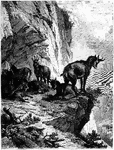
Chamois
The chamois (Rupicapra rupicapra) is a goat-like animal, living at moderately high altitudes and are…

Wilhelma
The Wilhelma was originally a royal palace, mimicking Moorish architecture. After the second world war,…

Animals Outline Tangram Card
Outlines of animals (bear, kangaroo, camel, giraffe) made from tangram pieces. Tangrams, invented by…
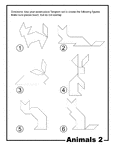
Animals Outline Tangram Card #2
Outlines of animals (fox, rabbit, cat) made from tangram pieces. Tangrams, invented by the Chinese,…
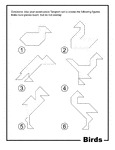
Birds Outline Tangram Card
Outlines of birds (duck, swan, turkey vulture, cormorant, and egret) made from tangram pieces. Tangrams,…
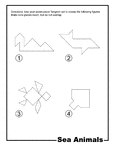
Sea Animals Outline Tangram Card
Outlines of sea animals (sea monster, dolphin, sea turtle, stingray) made from tangram pieces. Tangrams,…
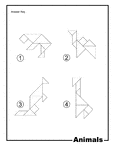
Animals Outline Solution Tangram Card
Solutions for outlines of animals (bear, kangaroo, camel, giraffe) made from tangram pieces. Tangrams,…
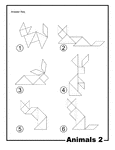
Animals Outline Solution Tangram Card #2
Solutions for outlines of animals (fox, rabbit, cat) made from tangram pieces. Tangrams, invented by…
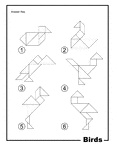
Birds Outline Solution Tangram Card
Solutions for outlines of birds (duck, swan, turkey vulture, cormorant, and egret) made from tangram…
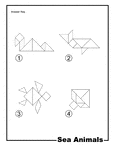
Sea Animals Outline Solution Tangram Card
Solutions for outlines of sea animals (sea monster, dolphin, sea turtle, stingray) made from tangram…
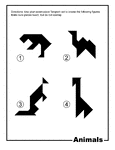
Animals Silhouette Tangram Card
Silhouette outlines of animals (bear, kangaroo, camel, giraffe) made from tangram pieces. Tangrams,…
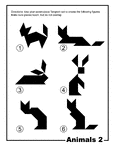
Animals Silhouette Tangram Card #2
Silhouette outlines of animals (fox, rabbit, cat) made from tangram pieces. Tangrams, invented by the…
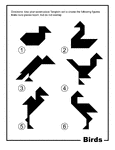
Birds Silhouette Tangram Card
Silhouette outlines of birds (duck, swan, turkey vulture, cormorant, and egret) made from tangram pieces.…
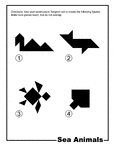
Sea Animals Silhouette Tangram Card
Silhouette outlines of sea animals (sea monster, dolphin, sea turtle, stingray) made from tangram pieces.…
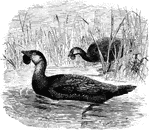
Two Musk Ducks Swimming between the Tall Grass in a Lake
Biziura lobata, (Musk Duck) of Tasmania and Australia -except the north-is brown with buff mottlings,…
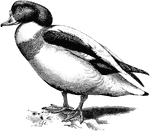
Shelduck
Tadorna cornuta, the Sheld-Drake or Bargander, ...shews a white collar on the lower neck followed by…
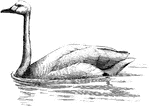
Bewick's Swan
"Cygnus bewicki, Buck's Swan, is white with black feet and bill, the basal half of the latter being…
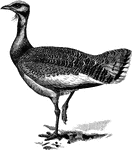
Great Bustard
"The Otis Tarda, the Great Bustard, which, as a native only became extinct in Norfolk about 1838, used…
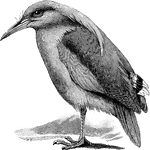
Kagu
"Rhinochetus jubatus, the Kuga ... has powder-down patches that are profusely distributed over the whole…
